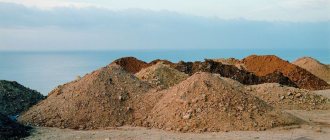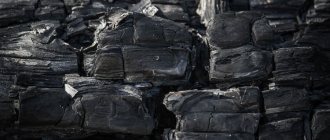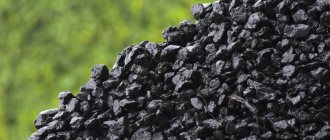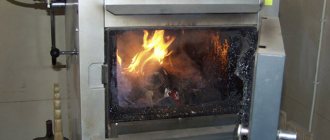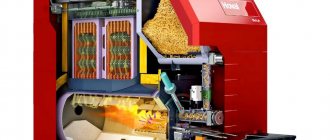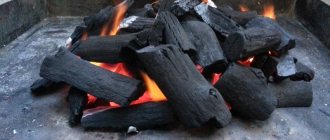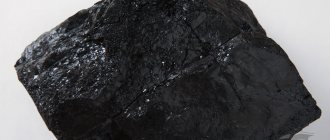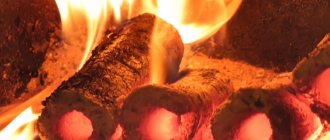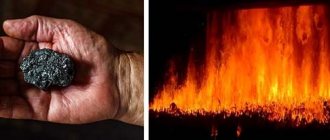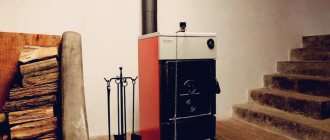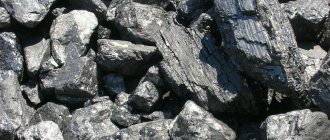Basic ways to save heat
Economical heating of a private house with wood has become possible thanks to the use of modern stoves: fireplaces with closed fireboxes have doubled the efficiency, and it reaches 75%, just like good gas stoves. Even if you decide to install a regular Russian stove, its efficiency can also vary significantly.
This depends on the materials, the correctness of the masonry, and the performance of the chimney. A wood heating stove with an efficiency of 90% remains an unattainable dream for many: so far only high-tech gas equipment can boast such efficiency.
When heating a house with wood, consumption can be reduced using simple “rustic” methods that have been used for decades. A few basic measures will make it possible to significantly reduce heating costs:
The optimal amount of heat is provided only by dry firewood, the combustion of which produces clear smoke with a pleasant woody smell. When burning wet wood, white steam appears - the evaporation of water leads to wasted heat loss and ineffective combustion of fuel.
It is not difficult to distinguish dry wood: if you hit one log on another, the sound should be clear
It is important to ensure proper storage of firewood, then it will always be ready for use
The efficiency of the stove is significantly reduced if the chimney is clogged with ash and soot. At the same time, traction deteriorates, and due to an insufficient supply of oxygen, the fuel does not burn completely, giving off a minimum of heat.
In addition, toxic carbon monoxide can be released, which can negatively affect human health. Regular cleaning of furnaces can completely solve the problem: removing soot from the walls increases the performance of the entire system.
There is another method, which, according to home owners, makes it possible to reduce fuel consumption by half. It involves taking combustion air not from the room, but from the street: the increased flow of oxygen allows the wood to burn out entirely, while it will not take heat from the house.
Thus, modern gas boilers are initially designed to take air from the street. When modifying the design, the stove can take air from the basement of the house.
The most important condition for saving fuel is proper insulation of the house. It is necessary to insulate not only the walls, but also the floor, foundation, and roof.
Most of the heat simply leaves the house through unsealed cracks in the walls or cold bridges in the under-roof space. For your home, you can use modern insulation in combination with waterproofing and vapor barrier membranes.
An economical wood-burning stove for heating a house involves the use of a water or air circuit for heating. In this case, the heat will be evenly distributed throughout the rooms, and for this it is not necessary to use a large amount of fuel.
Such heating is possible by installing an additional heat exchanger in the furnace structure: the most common solution is the so-called “water jacket”. The water is heated by the combustion of fuel and enters the piping system to the radiators, after which it returns to the furnace.
This heating system eliminates the main drawback of a traditional wood stove: uneven heating of the air in the rooms. If it is always very warm near the stove, then in distant rooms the air will always be much colder. If you install radiators and turn an ordinary stove into a solid fuel boiler, this will allow you to warm up every room.
Wood fuel briquette RUF
Home » Questions and Answers
WOOD FUEL BRIQUETTES – EUROWOOD
How to correctly calculate the required amount of eurowood for the heating season?
If you have been using regular firewood until now and decided to switch to fuel briquettes, then you can calculate the required supply of European firewood as follows:
Divide the previously purchased volume of regular firewood by 5 (five). The resulting number will be the required supply of briquettes in tons. In other words, 1 ton of Euro firewood replaces 5-6 m3 of ordinary firewood in terms of heat transfer.
Heating a house of 200 m2 requires 1 ton of eurowood per month.
The figures given above are approximate. The actual amount of fuel required depends on the quality of the home’s insulation, the type of stove or boiler, the efficiency of the heating system, the number of residents, the temperature conditions of the building, etc.
How to store Eurowood?
Wood fuel briquettes (euro firewood) are packed in plastic film in packs of 12 pieces weighing 10 kg. Packs of briquettes should be stored in a ventilated area where there is no open moisture. In winter, when the temperature does not cross zero, Euro-firewood can be stored outside covered with film; it is undesirable for moisture to enter in liquid form, for example, when snow melts on top of a pallet with briquettes. In summer, briquettes cannot be stored on the ground without being separated by a film from below from the fumes from the soil, because At night, moisture condenses on the packs of briquettes - in this case, on the bottom of the pallet under the packs, you need to arrange a hermetically sealed insulation from the ground, for example, with plastic film. Also, briquettes should not be stored in an unventilated, damp area, such as a basement. Briquettes leave production with a moisture content of 4-6%. If stored improperly in a damp room or if damaged packaging is openly exposed to moisture, Euro firewood will swell and lose strength. This, by the way, is an important advantage of briquettes - wet briquettes are immediately visible. Only high-quality briquettes can be durable - the increased humidity of ordinary firewood is more difficult to determine by appearance.
How many logs does 1 briquette replace?
Let's take as an example the average size of a log - length 30 cm, let's make a small assumption - let it be a log of wood with a diameter of 18 cm split into 4 parts. The volume of the log is 1908 cubic meters. cm. The density of dry aspen wood is approximately 500 kg/cubic meter, birch wood is 650 kg/cubic meter. The calorie content of any wood at 20% humidity is the same 4.16 kWh/kg. The briquette weight is 840 g, the calorific value of European firewood at 8% humidity is 4.88 kWh/kg.
1 aspen log contains - 0.001908 x 500 x 4.16 = 3.97 kWh of heat 1 birch log contains - 0.001908 x 650 x 4.16 = 5.16 kWh of heat 1 briquette contains - 0.84 x 4, 88 = 4.10 kWh heat.
Those. 1 wood fuel brique is approximately equal in heat content to 1 dried log 30 cm long.
My briquettes burn out quickly, faster than the wood I always used to heat the stove. What is the problem?
Wood briquettes - Euro firewood, compared to firewood, even dry firewood, have a much greater calorific value (briquettes are 2.2 times more caloric than undried firewood and 20% more caloric than dry firewood based on weight). When European wood is burned in the furnace and boiler firebox, a higher temperature develops due to this. And, as is known, when the temperature of the flue gases increases, the draft increases and combustion products leave the furnace more quickly. At the same time, they do not have time to transfer the heat generated during combustion to the walls of the furnace or the heat exchangers of the boiler.
In connection with the above, it is necessary to reduce the air supply to the firebox, for example, slightly cover the vent or, if air is supplied through a gap in the firebox door, reduce this hole. You can also recommend putting less eurowood in the firebox than firewood.
How many briquettes should I put in the firebox?
When switching from regular firewood to fuel briquettes, you need to be very careful. Since Euro-firewood has a much higher density and lower humidity, the amount of heat from it is 3-6 times greater than from the same volume of conventional firewood. Therefore, we recommend that you make several test fires, placing briquettes 3-6 times less in volume. In addition, different types of briquettes have different sizes and, accordingly, weight. This also needs to be taken into account. So one RUF briquette weighs approximately 0.80-0.85 kg, and a large round one weighs 2-2.5 kg. As a guide, you can use the following ratio: 1 RUF briquette (“brick”) = 1 log (8 x 30 cm, well-dried birch). If you overdo it with the number of fuel briquettes, this can cause overheating of the boiler (stove), boiling of the coolant and, as a result, deformation of the heating device itself, the chimney and the piping (if it is made of plastic pipes).
Is it possible to use Eurowood in pyrolysis boilers?
Using fuel briquettes in pyrolysis boilers is not only possible, but also highly recommended. Since one of the main requirements for fuel for a pyrolyzer is low humidity. And European firewood has a humidity of only 8-12%. Ordinary firewood, as a rule, is not even close to such indicators!
What are the disadvantages of fuel briquettes?
Compared to ordinary firewood or coal, fuel briquettes have only one drawback: you need to take a more responsible approach to the issue of storage. If you can afford to simply throw firewood in the yard in the open air, then briquettes for heating should be stored indoors or under a canopy. Fuel briquettes are afraid of direct moisture.
QUESTIONS - ANSWERS. WHAT DO WE KNOW ABOUT PELLETS?
What are pellets?
Pellets are pressed fuel granules that are made from sawdust, shavings, straw, husks and other waste from woodworking and agriculture. Wood pellets have the form of small cylinders with an average length of 10–30 mm and a diameter of 6–8 mm. High-quality pellets are environmentally friendly fuel, since the binder of the feedstock is lignin (a natural plant component), and not chemical adhesive additives.
How to store pellets?
The main condition for storing pellets is the absence of direct moisture. It is possible to store it outdoors on wooden pallets and under a canopy. Pellets can be stored indefinitely.
What is the consumption of pellets for heating?
In a house with good insulation, 6 grams per 1 sq.m. per hour i.e. per 100 sq.m. houses with good insulation 432 kg. per month; in a house with poor insulation 10 grams per 1 sq.m. per hour i.e. per 100 sq.m. houses with poorly insulated area 720 kg. per month Based on this calculation, you can calculate the approximate cost of heating.
How to take a steam bath without a broom????????
It often happens like this: you come to the bathhouse, but there is no broom. How can you take a steam bath without it? An inexperienced visitor will give up and go steaming “idle”: he will sit on the shelves and squeeze out precious drops of sweat. An inveterate lover of steaming will always find a way out. There are several ways that will somehow brighten up our “unenviable” fate. This is what I will try to write about. Imagine that an ordinary sheet would be useful for this purpose. Of course, it cannot completely replace a bath broom, but it is quite possible to get a minimal effect from steaming and improve your health in this way. So, for convenience, let’s call the person being steamed a client, and the one performing this procedure a steamer. We choose a place in the steam room so that the client can lie down freely and comfortably. Lay the sheet out on the shelf, aligning the near edge with the edge of the shelf. We assemble the opposite side and place it along the wall of the steam room. The client lies on his stomach on the sheet, positioning his body along the shelf. The steamer stands on the side of the client and covers him (except for his head) with the free part of the sheet. Grabbing the two ends of the upper part, the steamer lifts it up. The hands should perform such movements as if he were capturing the hottest steam from above. Then you need to quickly lower the sheet onto your body. Repeat this 5-8 times. After this, lower the sheet and rub the body with your hands, which will remove sweat and at the same time carry out a bath massage. It is quite enough to carry out 3-4 cycles. After this, you can roll over onto your back and hover in the same order. All! The procedure is completed. How to take a steam bath if there are no sheets It is difficult to imagine that this is even possible. But, still, anything happens in our lives. In this case, a terry bath towel from one to one and a half meters long will come to the rescue. Let's see how to use it correctly below: Fold the towel in half along its length, and then again, but this time across. Place your right hand (or left) through the folded towel. Tie a knot at your wrist. Use your palm to grab the loose ends. “device” to steam yourself like an ordinary broom and rub your body from time to time. It should be taken into account that during the steaming process the towel will absorb sweat. This will make it heavier, which will require additional physical effort. For women, this method may seem difficult, but for men it is quite possible. You can always find a way out!!!!!!!!! :))))))))))))) Bath procedures sometimes require us to be ingenious and able to use available items in order to get the greatest benefit from visiting the bath. There is no doubt that each of you will have your own techniques and ways out of situations like these. The main thing is to solve the problem of how to take a steam bath without having any bath accessories.
Continue
Factors influencing the level of solid fuel consumption
It is not difficult to calculate how much a solid fuel heating boiler consumes. It is more difficult to correctly select the initial data to perform calculations.
The following presents the calculation method and at the same time provides a calculation of the consumption of the amount of firewood to heat a home of 100 m². However, first let's look at the source data:
- the type of wood that is selected for kindling;
- wood moisture level;
- efficiency factor of a solid fuel stove or boiler;
- thermal power required to heat the room.
If you've ever used a stove, you're probably aware that when wood burns, different types of wood produce different amounts of heat. Let's say birch logs emit more heat than poplar or pine. This is due to the difference in density and thermal output of tree species. In addition, the volume of firewood per 1 kW of heat energy depends on the moisture content in it. Accordingly, the higher the humidity, the more heat is spent on evaporating liquid from the firewood, and less is left for heating the home. As a result, more fuel will be needed to heat the house.
How rationally the energy contained in the fuel will be used depends on the efficiency of a particular heat source. Let’s say a fireplace or stove releases most of its energy into the atmosphere along with combustion products, so their heat transfer reaches only 60%. At the same time, a solid fuel or pyrolysis (long-burning) boiler operates with a heat output of 80%. These nuances should be taken into account when calculating the cost of heating a home.
It is better to take the value of the thermal power required to heat the house according to the calculation made by the craftsmen during the design of the home. However, often such data is not stored by property owners. Therefore, the amount of firewood and its cost can be determined by the average value of power consumption. It is determined in a standard way: heating 10 m² requires 1 kW of heat under the worst conditions, and the average for the season is 0.5 kW. The average figure for a dwelling with an area of 100 m² will be 5 kW/h.
How much wood is required to heat a house?
We always look at the quality of the firewood we buy. Soft wood burns quickly, but does not produce much heat. Preference is given to hard rocks, which, although they burn slowly, provide a lot of heat to the project. Rotten firewood very often comes across on sale. When you prepare firewood yourself, this will never happen. And most often they sell raw wood.
It turns out that for a private house or cottage it is best to find about 10 cubic meters of firewood for the season. In order not to spend money on buying chopped firewood, you can start harvesting it yourself. Moreover, near the summer cottage there will always be a forest where there is a fallen old tree. An excellent option for preparing firewood is to take advantage of the moment when someone is dismantling an old wooden house.
Equipment for preparing firewood for the winter
You cannot prepare a lot of firewood with a hacksaw or an ax. In addition, you need to put in a lot of effort.
In order to carry out preparation work, you need to buy special tools, of which there are not so many.
In order to cut a tree trunk in the forest, you need to choose a good chainsaw. The best option is a device with a power of up to two kilowatts. If the work will be carried out near the house, then there is an option to use an electric saw. There are types of saws on sale that are equipped with batteries. If the work will be carried out very often, it is recommended to buy semi-professional saws. Their power is higher than two kilowatts, and their price is higher.
Then, to chop firewood, you need to buy a high-quality horizontal type wood splitter. For the home, this is the best device that works safely. Working with a wood splitter is simple: you need to turn on the device, which runs on electricity, then put in a log, and then wait for the knife to split it.
There will be trash after the work. And here you will need a shredder that can be used to process the waste. Wood chips, shavings, and leaves can be quickly turned into fertilizer for the garden.
If you want to purchase high-quality equipment, you will have to shell out a lot of money. However, the tools will last a long time. After a while they will fully pay for themselves. For those who think that buying ready-made firewood is cheaper, they are deeply mistaken. For example, what does it cost just to deliver ready-made firewood, and then you also need to store it. Firewood is stored under special sheds or in woodpiles.
Do-it-yourself firewood shed at the dacha, photo
Sheds for storing firewood in winter at the dacha
shed for storing firewood in winter
Experts have proven that self-harvesting wood is much cheaper for the owner, even if he has spent significant amounts of money on purchasing garden equipment.
What you need to know to calculate
How much firewood is needed to heat a house depends on several factors:
- the amount of thermal power spent on heating;
- equipment in use;
- types of wood;
- wood humidity.
According to the standards, the thermal power is 1 kW of heat per 10 sq. m in extreme cold. The average value is 0.5 kW. Thus, for a building of 100 sq. m it will be 5 kW.
The more spacious the housing, the higher the fuel consumption. The efficiency of different types of heating devices differs. For most solid fuel boilers this parameter reaches 70–75%. Pyrolysis models are more efficient - their efficiency reaches 80%. Russian and steel stoves have the lowest heat output. Their efficiency on average is 65%, 55%, respectively.
Deciduous and coniferous trees are used for heating. Birch has the highest heat transfer – 2371 kW/cu.m. m at 50% moisture content and 2716 kW/cu.m. m at 20% water content. The minimum calorific value of a Christmas tree is 1667 kW/m3 at a humidity of 50% and 1902 kW/m3 at a moisture content of 20%.
| Wood type | Calorific value of freshly cut wood at 50% humidity, kW/m3 | Calorific value of semi-dry wood 30% humidity | Calorific value of dry wood 20% humidity, kW/m3 |
| Pine | 1900 | 2071 | 2166 |
| Birch | 2371 | 2579 | 2716 |
| Spruce | 1667 | 1817 | 1902 |
| Aspen | 1835 | 1995 | 2117 |
| Alder | 1972 | 2148 | 2244 |
| Ash | 2550 | 2774 | 2907 |
Table 1. The calorific value of firewood of different types, related to the measure of volume - 1 m³.
When preparing for wintering, you need to know how to calculate cubes of firewood. For this purpose, special formulas have been developed to calculate the norm of logs for the autumn-winter season.
Calculation example for a house of 100 m²
To clarify the procedure for calculations, it is worth considering them using the example of a country house with an area of 100 m² and a heat consumption for heating of 5 kW/h on average per season. Let us assume that in a traditional boiler with an efficiency of 75%, split birch firewood 60 cm long with a humidity of 50% (freshly cut) is burned. Taking from the table above the calorific value for raw birch 2371 kW/m³, we substitute the data into the formula:
V = 720 x 5 / (2371 x 0.01 x 75) = 2.02 m³
Next, you need to find out the real monthly volume of birch logs, expressed in storage meters. We find the conversion factor in the second table; for chopped hardwood firewood 0.6 m long it is 0.71. Determine the actual volume of fuel:
2.02 / 0.71 = 2.85 m³
If the heating season lasts 6 months, you will have to burn 2.85 x 6 = 17.1 m³ of raw birch. Now you can check it with an online calculator on this Internet resource. The calculator readings differ from the calculated ones to a lesser extent - 2.8 m³ of birch logs is needed for 1 month, for the winter - 2.8 x 6 = 16.8 m³.
If you fold logs brought in bulk in the back of a dump truck normally, they will take up a little less space
Coal categories
Coal available for sale for solid fuel boilers is classified as follows:
- Anthracite.
- Long flame.
- Long flame gas.
Based on the size of the pieces, fuel is divided into:
- Large or “fist” 50-100 millimeters.
- Medium or “nut” 25-50 millimeters.
- Small or “seed” 10-25 millimeters.
All types of coal suitable for heating have different heat output and leave different amounts of waste after combustion. When burned, long-flame and gas coal produce furnace gas and smoke in large quantities. Anthracite burns without smoke and leaves a minimal amount of ash.
Rice. 2 Anthracite is the leader among coal grades
The best coal for heating private houses is medium anthracite; its consumption is minimal, so the price is almost twice as high as other types.
Advantages and disadvantages of pellet boilers
The equipment has a wide list of advantages:
- high efficiency up to 97%
- automation of the process, which explains the high safety indicators for using the units;
- boilers are considered long-burning equipment;
- unpretentiousness of service;
- the ability to equip the system with remote sensors to control the heating temperature of the coolant.
Combined heating boilers for a private home
Installation of pellet boilers does not require permits; installation and commissioning are simple and therefore do not pose any difficulties for the home craftsman. In addition, if additionally equipped with a control module, the device can be controlled remotely via a mobile application.
But there are a number of disadvantages:
- High price per unit of heat received. To maintain normal heating in regions with harsh winters, about 1000 kg of pellets are consumed per month; it is not difficult to calculate how much the entire heating season will cost.
- Boilers require connection to a power supply or generator and additional technical equipment. The generator will allow the equipment to function autonomously, for example, during power outages.
Chimney device
Chimney device
Regardless of the material used for installation, all chimneys for solid fuel boilers are structurally similar. The smoke removal system consists of the same functional components:
- Chimney. A cylindrical or rectangular section through which combustion products are removed from the boiler. Must be made of durable and heat-resistant material.
- Condensate collector. Everyone remembers from the physics course that heated air, when it comes into contact with a cold surface, forms condensation on it - small accumulations of moisture. To prevent drops of water from flowing into the boiler, the chimney must be equipped with a means to remove them from the system. A condensate collector is equipped in its lower part, which does not contact the boiler directly, but is connected through a tee.
- Gate - a barrier to stop the supply of air to the system from the boiler. The damper is necessary for economical operation - so that after the boiler stops operating, the exit of warm air into the external environment is blocked.
This is a typical smoke exhaust system. When working with specific materials, it may have slight differences and additions. For example, steel chimneys are equipped with a linear deformation compensator. It is responsible for the tightness and reliability of the system, because constant cycles of heating and cooling lead to loosening of the chimney. This reduces the density of components joining.
Which firewood is better
The wood that serves as raw material for firewood is far from identical in its properties.
Hard wood species such as birch, oak, hornbeam, beech, and yew burn hotter, have a high fibrous density, and burn more slowly.
Soft varieties have their advantages, for example: aspen produces 25% less heat than birch, but it perfectly maintains heat in a heated stove. Alder still shares a delightful aroma, as do coniferous varieties. Alder and aspen, added to the stove at the end of heating, remove soot and soot deposits in the chimney. But the formation of plaque, which can lead to clogging of the chimney, occurs during the combustion of essential oils and resins of pine, fir, and spruce. Conifers are also inferior in calorific value to birch and oak, but they dry out faster and are more suitable for kindling. Only fir sparks strongly, and larch emits a lot of carbon monoxide at the end of combustion and you need to be more careful with the damper.
Some types of fruit trees are classified as medium-hard wood and their calorific value is average. They burn, emitting an aroma, and are easy to prepare, since the wood can be split without much effort.
Based on the above, it is difficult to recommend any one type of wood for stove or fireplace firewood. As fuel, hard deciduous tree varieties are the most efficient. Even flame, high heat output, less soot and ash. But the aroma of coniferous trees has a therapeutic effect, and is well suited for lighting. By combining several varieties, it is possible to maintain both the working condition of the chimney, stove, and a comfortable microclimate throughout the cold period, subject to the initial investment in a good one. Otherwise, any heat, along with your funds, will fly into the pipe and evaporate through the cracks.
Coal qualities
It is safe to heat residential premises with coal these days; the use of solid fuel boilers has become much simpler, so coal as a fuel is in maximum demand.
The consumer properties of coal are very attractive:
- Enormous heat transfer produces more heat per unit area.
- Dependence on the availability of a gas pipeline and the ability to connect to it is eliminated.
- There is no need to construct special sealed containers to store this fuel.
- Coal does not lose its consumer properties under the influence of water.
- The installation of a boiler room with a solid fuel heating device does not depend on the consent of special government bodies.
- Convenient packaging ensures transportation to any location.
How much does it cost to heat with wood?
On average, for heating a house with wood, the cost is calculated according to the following value: the price of 1 kW/hour is 0.7 rubles, which is about 3 times cheaper than when using electricity. On average, 1 heating season costs about 70,000 rubles, that is, approximately 10,000 rubles per month. The calculations are approximate, but from them you can first determine whether this heating method is beneficial for the household.
Fuel is usually purchased in advance, and it is more profitable to immediately purchase a large batch, designed to last for several years. In rural areas, purchasing firewood is usually not difficult; in some areas it is still possible to prepare it yourself.
When making calculations, you need to take into account the possibility of a colder winter than usual: the weather in Russia is completely unpredictable, and depending on meteorological factors, the consumption of firewood varies significantly. This is another reason to buy firewood in advance: if there is fuel left, you can buy less for next year, and if the winter is very cold, there will be no problems with fuel shortages.
With all the pros and cons, heating with wood remains a very profitable solution for many areas. It is difficult to find a more affordable and reliable fuel that will protect your home from even the most severe cold weather and not depend on any centralized networks. Wood heating is now gaining popularity in Europe, as humanity is trying to return to renewable energy sources using more modern energy-saving equipment.
Egor Kondratyuk
Author of publications on 1Drevo.ru with the topics: Houses made of rounded logs | House made of rounded timber | Gas boiler for home | Rounded garage | Choosing an electric boiler | Polycarbonate canopy | Clapboard finishing | Base finishing | Log house for shrinkage | External insulation | Cedar house | Profiled timber | Wooden fence | Finnish house made of timber | Roof installation | Shallow foundation, etc.
Was this publication useful to you?
Total score: 4Votes: 43
Modern wood stoves for heating a home: which one to choose
Stoves for water heating in a private house
We recommend! — Encyclopedia Wooden Houses — NEW
You can find out detailed and expanded information on the topic of the article from the book “Wooden Houses,” which reflects all stages of building a house, from laying the foundation to installing the roof. Book price = 77 rubles.
You may also be interested in other BOOKS on building houses from wood with your own hands.
We recommend other posts on this topic:
How much does it cost to heat a house with electricity: costs of heating a house Modern electric heating systems for a country house
Heating a country house with wood or electricity - what to choose
A stove with a water circuit for heating a house: how to make it yourself
Wooden shower for a summer cottage with heating
Electric heating options: what to choose for a wooden house
Advantages and disadvantages
The obvious advantages of this type of fuel include the following:
- no harm if stored correctly;
- adequate, stable price on the commodity market;
- use of automated equipment.
Among the shortcomings we note:
- the need for a large warehouse for winter storage;
- with the onset of the warm season, it is necessary to control the humidity in the pellet warehouse;
- the price for such a fuel installation is much higher than when purchasing electric or gas boiler structures.
Methodology for calculating the amount of fuel for the season
Let's figure out how to calculate the consumption of any type of fuel for a room. First, we will calculate how much heat is needed to heat the entire house per hour. Multiplying by 24, we get the daily value, then multiplying by 30 and 111 days, what is the consumption per month and for the entire heating period.
After this, we calculate the heat transfer of the accepted unit of measurement for each type of solid fuel. By dividing the amount of heat required per month and season by heat transfer, we will see how much of this type of combustible material is needed per month and for the whole year. This will show us how much fuel we need to store for the winter and allow us to compare the efficiency of different devices.
Approximate calculation of solid fuel for a house with an area of 100 square meters
Firewood
To heat a house of 100 square meters, we need 100 square meters. m. * 100 W = 10 kilowatts of thermal energy per hour. Accordingly, per day it will be 10 kW/h * 24 hours = 240 kW. We will need 240 kW/day per month * 30 days = 7200 kilowatts, for the entire heating period 240 kW/day * 111 days = 26,640 kW.
Sometimes, calculations are based on the fact that the flame burns actively only 10 hours a day, which is enough to maintain the set temperature. Then the required amount of heat is 10 kW/h * 10 h = 100 kW. Often, based on this parameter, the consumption is written in the operating instructions.
On average, when burning 1 kg of oak wood, 3.4 kW is released. 240 / 3.4 = 70.6 kg of firewood will be burned per day, 7200 / 3.4 = 2117.64 kg per month, 26,640 / 3.4 = 7835.29 kg per winter. That is, in one winter, a solid fuel device burns almost 8 tons of wood.
It is also important to take into account that the calculation of consumption is also greatly influenced by the quality of the firewood, in particular its humidity, the type of wood it is made of, as well as the conditions of its storage. To heat such a house with firewood, a Zota 15a device is suitable.
Coal
One kilogram of coal emits 7.75 kilowatts when burned. Coal-fired equipment consumes 240 /7.75 = 31 kg of fuel per day. 7200 / 7.75 = 929 kg of coal will be required per month, for the entire heating season 26,640 / 7.75 = 3437.5 kg.
How much coal you will have to stock up and load at each load is greatly influenced by its type, ash content and the amount of foreign impurities. For heating this room with coal, the Teplodar Kupper OVK 10 solid fuel boiler model is suitable.
For industrial premises with an area of 5000 sq.m. m., a cast iron hot water boiler from Bratsk, running on coal with pieces of up to 100 mm in size, or Universal 5 and Universal 6 equipment are suitable.
Briquettes
A kilogram of briquettes, when burned, emits an average of 6.2 kilowatts. In one day 240 / 6.2 = 38.7 kg will be consumed, in a month 7200 / 6.2 = 1161 kg, in the winter season 4297 kg of briquettes. You can heat such a house with briquettes using the Peresvet T 10 device.
How to choose the power of a solid fuel boiler
A solid fuel boiler must be selected so that its rated heating power corresponds to the heat losses of the heated object.
Choosing a boiler with a rated power that is too high leads to the fact that the boiler operates in a mode of significant power limitation most of the time. And this, in turn, leads to a decrease in efficiency (increased fuel consumption), increased formation of deposits (soot, tar), accelerated corrosion of the boiler and chimney. The risk of overheating of the coolant in the boiler increases. The cost of boilers increases as power increases.
Therefore, you should not buy a boiler with significantly higher power
than heat losses at home.
True, when selecting a boiler with a large power reserve, the burning time of one load of fuel increases - there is more firewood in the firebox. But, this advantage can be realized profitably only in a heating system with a heat accumulator.
Accurately calculating the heat losses of a house and the power of a heating boiler is quite a complex task, the solution of which is best entrusted to specialist designers. Managers of a company that sells boilers will most likely advise you to choose a boiler with excess power - this is beneficial for them.
The approximate power of the boiler for heating a house is selected based on the generally accepted values of specific power per 10 m2 of heated area according to climatic zones:
- For the southern regions of Russia: 0.7 - 0.9 kW/10m2.
- For the middle zone - 1.2 - 1.5 kW/10m2.
- For northern regions - 1.5 - 2 kW/10m2.
For example, for the Moscow region, in a house with a heated area of 150 m2, a boiler with a capacity of 150 m2 x 1.2 kW/10 m2 = 18 kW should be installed.
For a house built in compliance with modern energy saving requirements, the smaller of the specified values is used for calculations.
It is recommended to increase the boiler power by approximately 30% when operating the boiler with a buffer tank - a heat accumulator. A power reserve is also necessary if the boiler is used in a hot water supply system.
It should also be taken into account that the heat capacity of non-freezing liquids is 20% lower than that of water. When used as a coolant, the boiler power may drop by 10 - 15% of the nominal value.
It is recommended to use a water heating system with natural coolant circulation in houses with a heated area of no more than 100 m2. In larger houses or in heating systems with heated floors, forced circulation of the coolant is used with the installation of circulation pumps.
How to save money on heating your home
Let's figure out how to reduce fuel consumption for heating your home. First of all, you should take care of high-quality thermal insulation of the room. By insulating your house in advance with modern materials, you will be able to consume less fuel by retaining heat, preventing the penetration of cold and taking longer to cool down.
This is also affected by the quality of the windows. It is advisable to call specialists who, using modern measuring equipment, can find particularly vulnerable spots in the house and insulate them.
In second place in terms of cost efficiency is the choice of modern solid fuel (SF) equipment. The pyrolysis apparatus and long-burning boiler have increased efficiency compared to classical models. The equipment configuration also determines how much fuel burns per load and how often you will have to add flammable materials.
The frequency of solid fuel loading varies greatly over time depending on the design of the apparatus. How much can be added at a time depends on the volume of the combustion chamber.
It is also effective to install a thermostat in the room. This will eliminate excessive boiler operation. An automatic electronic system will be the most efficient way to use boiler resources, saving an additional 10-15%.
Long burning boilers.
The last group of boilers that can use solid fuel heating are long-burning boilers. There are several special systems that ensure long-term combustion of fuel. The first is the Canadian Buleryan boiler system. The principle of its operation is based on the presence of a two-chamber wood burning stove, divided horizontally. In the lower chamber, gases are released as a result of smoldering fuel. Entering the upper chamber, they are mixed with secondary air through a jet, which leads to afterburning of the fuel. The second system is Stropuva. It is a tall barrel, the height of which can reach 3 m. The container is filled with fuel and covered with a movable lid, to which a chimney is connected. After igniting the firewood, it begins to burn economically and heat the heat carrier along the jacket of the barrel. Solid fuel heating operating using such a system automatically regulates the air supply.
Which firewood is better
The wood that serves as raw material for firewood is far from identical in its properties.
Hard wood species such as birch, oak, hornbeam, beech, and yew burn hotter, have a high fibrous density, and burn more slowly.
Soft varieties have their advantages, for example: aspen produces 25% less heat than birch, but it perfectly maintains heat in a heated stove. Alder still shares a delightful aroma, as do coniferous varieties. Alder and aspen, added to the stove at the end of heating, remove soot and soot deposits in the chimney. But the formation of plaque, which can lead to clogging of the chimney, occurs during the combustion of essential oils and resins of pine, fir, and spruce. Conifers are also inferior in calorific value to birch and oak, but they dry out faster and are more suitable for kindling. Only fir sparks strongly, and larch emits a lot of carbon monoxide at the end of combustion and you need to be more careful with the damper.
Some types of fruit trees are classified as medium-hard wood and their calorific value is average. They burn, emitting an aroma, and are easy to prepare, since the wood can be split without much effort.
Choosing a wood briquette boiler
Choosing a long-burning boiler using pressed wood briquettes can be difficult due to the large range of products offered. Models manufactured in Russia, European countries and neighboring countries are offered on the domestic market.
To facilitate the selection of equipment, all offered boilers for burning briquettes can be divided into several categories, based on territoriality - country of manufacture:
- Germany – Bosch Solid.
- Czech Republic - ATMOS, Dakon (the company is owned by Bosch), Wattek.
- Russia – Nibe Viking, Zharstal Dobrynya, Dragon.
- Türkiye – Radijator.
- Poland – Heiztechnik.
- Italy – Ferroli.
The proposed list contains boilers for burning briquettes using the principle of pyrolysis combustion. All models are always popular, as sales statistics clearly prove.
What is better to heat a boiler - with wood or briquettes?
A solid fuel boiler using wood briquettes, despite its good thermal performance, remains a rarity in most regions of Russia. But gradually the trends are changing.
To decide what to heat a solid fuel boiler with, wood or briquettes, it is worth considering what characteristics distinguish compressed fuel:
- Relative humidity – the indicator does not exceed 8-10%. Firewood, even after drying for two years, has a moisture content of at least 20%.
- Calorific value – varies at the level of 4.5-5 kW/kg. The same characteristics distinguish pellets and coal.
- Cost-effectiveness – the efficiency of a solid fuel pyrolysis boiler using wooden briquettes exceeds by 5.3% identical indicators when using coal.
The caloric content table for wood briquettes shows that compressed fuel is superior in its characteristics to ordinary wood. The constant use of stoves is economically beneficial and increases the battery life of solid fuel boilers.
By all indicators, the use of briquettes is more profitable. There are a few more parameters to consider:
- Technological results - combustion is characterized by stability and uniformity. With normal traction characteristics, the flame is bright yellow. During the combustion process, no soot is released. The chimney warms up quickly, there are no temperature changes. As a result of these features, a decrease in condensation is observed.
- Environmental characteristics – the emitted smoke is transparent. There is a sour smell. Combustion products do not contain harmful substances or soot that negatively affect human health.
- Production characteristics – briquettes make the work of service personnel easier. Even when using slabs in classic units, the operating time from one load increases to 8 hours. In pyrolysis or long-term combustion equipment, the time increases to 20 hours.
Taking into account all the characteristics, it is better to heat the boiler not with wood, but with briquettes.
How is fuel calculated for the season?
How to calculate firewood for heating a house:
720 – number of hours per month (24 hours * 30 days);
V – amount of biofuel for one month;
Q – heat required to heat the building (kilowatt-hour);
q is the calorific value of 1 cubic meter of wood depending on the degree of drying (kW/m3);
Efficiency – efficiency of the heating device (%).
| Length, m | Full wood coefficient for logs | |||||||
| Conifers | Hardwood | |||||||
| Round | Broken | A mixture of round and chopped | Round | Broken | A mixture of round and chopped | |||
| thin | average | thin | average | |||||
| 0,25 0,33 0,50 0,75 1,00 1,25 1,50 2,00 2,50 3,00 | 0,79 0,77 0,74 0,71 0,69 0,67 0,66 0,64 0,62 0,61 | 0,81 0,79 0,76 0,74 0,72 0,71 0,703 0,68 0,67 0,65 | 0,77 0,75 0,73 0,71 0,70 0,69 0,68 0,66 0,64 0,63 | 0,77 0,75 0,73 0,72 0,70 0,69 0,68 0,67 0,66 0,65 | 0,75 0,72 0,69 0,65 0,63 0,61 0,60 0,58 0,56 0,55 | 0,80 0,78 0,75 0,72 0,70 0,68 0,67 0,65 0,63 0,62 | 0,76 0,74 0,71 0,69 0,68 0,67 0,65 0,63 0,62 0,60 | 0,76 0,74 0,71 0,69 0,68 0,67 0,66 0,65 0,64 0,63 |
Table 2. Full wood coefficient for logs The result will be a value that will show the optimal volume of birch, spruce, ash to provide the living space with heat. But these are not ready-made logs that are put into the oven. To find out how much firewood is needed to heat a house, you need to divide the found value by the conversion factor. Each type of tree has its own
In addition, the shape, footage and thickness of the log are taken into account. For example, if it is round, of medium thickness, coniferous, then with a length of 50 cm the conversion factor is 0.72
To obtain the amount of solid fuel for the full season autumn - spring, you will need to multiply the resulting value by the number of months of the year in which the building will be heated.
conclusions
There is nothing complicated about how to heat autonomous solid fuel heating boilers with wood. The design of most products is simple and straightforward. Having certain skills and following safety measures will allow you to operate a solid fuel boiler in normal mode.
Firewood in the firebox can be stacked in different ways, in a row and in the form of a well. Such layout methods are usually used in traditional boilers, fireplaces and conventional stoves. For pyrolysis boilers and long-burning units, the stacking of firewood must be done as tightly as possible so that there are no air gaps between the logs. A working boiler must burn almost all the fuel contained in it.
Before lighting a fire in the firebox, check for draft. If your match or paper flares up with a white flame, there is excessive draft in the chimney. If, on the contrary, the flame turns red, the draft is insufficient. The most optimal option for working draft, when the flame has a yellow tint. All nuances and subtleties should be taken into account when working with wood-burning boilers. Not only your comfort and coziness, but also the duration of uninterrupted operation of the heating device depends on how you handle heating equipment.
Quality of pellet granules
The characteristics of fuel pellets determine further heating, its feasibility and functionality. Pressed briquettes for this type of boiler require compliance with storage and movement conditions. When compared with the requirements for liquid and gaseous fuel materials, the situation with pellets is much simpler. It is only important to control the permissible level of humidity in the room.
The quality of pellets can be determined by burning a small number of pellets in the firebox, which will be the determining factor in purchasing a whole batch. The key point here should be quality assurance based on the combustion of experimental samples.
If it is not possible to check the granules in this way, then we offer you alternative methods:
- Visual inspection of granules. The surface of the pellets should be smooth and shiny, without obvious cracks or chips. These indicators confirm compliance with the technological process at the time of manufacturing and pressing, and natural wood was used as a binder.
- Perform a fragility test. High-quality fuel material should not crumble upon palpation, so it is best to use solid granules. Pellets with a violation of the manufacturing process will begin to crumble already at the moment of transfer by auger equipment to the furnace.
- Choose pellets packed in bags. Under such conditions of storage and transportation, fuel will not combine with dust, which negatively affects the operation of the entire heating system.
- You should buy fuel material according to the parameters, sizes and types specified in the passport of the boiler installation itself.
- Study the shade of the granules. Light-colored pellets indicate the use in production of wood materials without bark and unnecessary impurities; they are considered the most effective for heating. Dark-colored granules indicate that the manufacturer used bark and wood waste as raw materials, so their effectiveness will be significantly lower.
